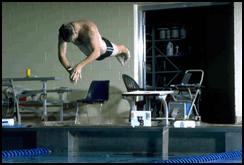The university is using a new, non-chemical method of sterilizing the pool in Alumni Arena-a method that was used at the Summer Olympics in Sydney-that could even help swimmers lower their times.
The days of constant, high-level chlorination may be over for the UB facility.
| |
 |
| |
UB swimmers could lower their times significantly if the university continues to use a UV system, instead of high levels of chlorine, to clean the Alumni pool. |
| |
photo: Frank Miller |
Ultraviolet light, once thought of as something out of science-fiction stories, is doing the job of cleaning-actually sterilizing-the pool and is doing it in a much safer way.
The system has been used at UB since last spring, thanks to a donation of equipment worth more than $55,000 from Wedeco/Ideal Horizons, a Poultney, Vt.-based company at the forefront of ultraviolet technology; Environmental Resources Management of Pittsford, the consultant for the project, and Final Filtration Inc. of Amherst.
The UB natatorium is the only pool in New York State to use the ultraviolet system, says Fred Smeader, manager of engineering support systems for Facilities Planning and Design.
Chlorine still is used in the Alumni pool, but at the minimum level required by the New York State Department of Health, Smeader says. He adds that the goal is to document the benefits of the UV system at UB and use that information to eventually override the state legislation requiring the use of chlorine in swimming pools. "If you're using UV, there's no need to use chlorine," he says.
Jamie Schlossberg, a graduate student in the Department of Civil Engineering who is working with faculty member James N. Jensen, is writing her thesis on the performance of the UV system, he says.
When used incorrectly, chlorine-a corrosive material-can be dangerous or even deadly to human beings, Smeader says. Too much or too little of the chemical in swimming pools can cause water quality to suffer and contribute to numerous water-borne illnesses.
In addition, chlorine may yellow and discolor wall surfaces at indoor pools and corrode metal surfaces, he says, noting that these problems will not occur with an ultraviolet water-purification system cleaning the pool.
Moreover, chlorine can change greatly the pH factor and odor of water, whereas UV does not have such an effect.
But perhaps the most important benefit of using the UV system could be on the performance and health of the swimmers.
Budd Termin, coach of the men's swim team, says the UV system provides a healthier environment.
"It totally cleans up the environment," says Termin, now in his 14th season as head coach. "Not only for our athletes, but also for the recreational users. From a skin-absorption standpoint, it's a huge health benefit."
And with a chemical-free pool, UB swimmers may even be able reduce their personal best times and post higher scores at championship meets, Termin says.
"Swimmers consume oxygen when they swim," he notes. "That oxygen consumption has a significant effect on their overall metabolic power, which correlates to improved swimming performance. Breathing a cleaner type of air could be a benefit to the athletes."
Smeader concurs, pointing out that competitive swimmers can spend as many as four or five hours at a time in and around a pool, breathing chlorine fumes.
"Oxygen levels are depleted, and they do not perform as well," he says.
Since installing the UV system, the change in water quality has been dramatic, Termin says, noting that swimmers can detect the slightest difference in the water, whether it is a change in temperature or how much or how little chlorine is present.
"Within a couple of days of installing the system," he says, "my swimmers were asking me if there was something different in the water."
Although the UV system is new to the United States, it is used widely throughout Europe, Smeader says. It is being used at a few American universities and competition facilities, including the University of Maryland-Baltimore County, the University of Texas, the University of Minnesota and the Indiana University Natatorium at Indiana University-Purdue University-Indianapolis where the U.S. Olympic Trials were held last summer.

